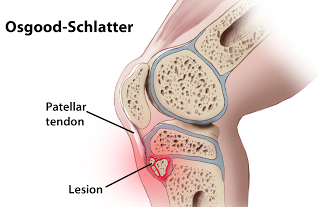Osgood-Schlatter disease occurs in adolescent athletes during growth spurts. As my young cousin Kendyll can attest it hurts! Often found in running athletes like soccer and basketball players OSD can be frustrating to children throughout their childhood until they reach skeletal maturity.
The bones of the body grow in areas called "growth plates." Growth plates are cartilage collections located at the ends of bones. These centers for growth are the last portion of the bone in children to harden--which occurs at skeletal maturity. Because the cartilage is softer then the surrounding bone, injury is more likely to happen in these areas. OSD is inflammation of the growth plate just below the knee cap.

The tibia is the shin bone in the lower leg. It helps form the knee joint and contains a growth plate just below the knee. The growth plate is at a site called the "tibial tubercle" a tubercle in the body means a bump in the bone that has a tendon attached to it. Note in figure #1 that the patellar tendon attaches to the tibial tuberosity. As a young soccer player repeatedly runs or jumps the patellar tendon pulls on the growth plate on the tibial tuberosity and can cause pain and swelling. (Figure #2)

Treatment can include nonoperative management with rest, stretching, strengthening, physical therapy, anti-inflammatory medications, ice, and bracing with a Cho-Pat strap. The Cho-Pat (figure #3) strap places pressure on the patellar tendon during activities and can provide some relief.

Unfortunately, even with treatment symptoms may continue to come and go until the child reaches full bone growth. This maybe be anywhere from around age 14-16 depending on sex. Even with the resolution of symptoms individuals may have a prominence of the tibial tubercle for their entire life. This is caused by the trauma to the growth plate which may never totally fuse to the bone underneath. This is called a "fibrous union" meaning that the growth plate is held on by tough tissue rather then bone. Adult patients usually have no symptoms related to the non-fused growth plate.
Very often we xray patients in the office and see old evidence that they had OSD as a child. It no longer effects them but they may have some bulging of the tibia in that area. Their xray looks like figure #4. Note that the tibial tubercle is slightly separated from the rest of the tibia. A minority of adults may have some pain with kneeling in this area, and rarely have the small bone growth removed surgically if symptoms are severe.

Osgood-Schlatter disease can be a struggle for children until they reach the end of their growth. However with some activity modifications and treatment they are able to have a full active childhood. Once they achieve full bone maturity they rarely have continued symptoms and can continue with an active adult life.
Next Topic: How nutrition can help in the healing process. It really is what you eat!
Sources:
http://kidshealth.org/parent/general/aches/osgood.html#
The information on this blog is intended for informational and educational purposes only. It is not intended to be used in place of medical advice. If you have orthopedic issues that need to be addressed please contact your physician.

